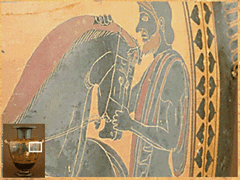

 |
Generally, Greek pots were formed, or thrown, on the potter's wheel.
The potter's wheel used in ancient Greece consisted of a turntable, on
which the clay was placed, and a disk or crank that the potter operated
with his knee to keep the turntable moving. This technique left both hands
free to form the pot from the clay as the turntable turned. Large pots
such as the hydria were made in sections and joined together later. Sections
were connected at the structural joints between the neck and body or the
foot and body. Thin coils of clay added on the outside concealed the marks
where the parts were joined. Handles were made by hand and attached with
SLIP.
Athenian potters used a high-quality clay that turned a beautiful reddish
brown when fired. To create the figures, the artist painted on the surface
of the vase with a liquified colored clay called ENGOBE
(on-GOBE). The presence of various metals suspended in the engobe causes
the range of color in the figures. The engobe that the Greeks used had
a high concentration of iron and perhaps traces of other metals such as
manganese or cobalt to create a rich black. Once the engobe was applied
and dried, the pot was placed in a KILN
and fired for many hours. The vessel itself turned a reddish brown, while
the engobe turned black in the firing. We call Greek ceramics made in
this manner "black figure" vessels.
| Details were INCISED in the black areas before firing by scraping through to the red clay with a sharp tool. For example, the lines that show details in the faces and clothing are all incised lines. Finally, accents of white and purple were applied with separate solutions after firing. On this hydria traces of white remain on Athena's face, and purple appears on the horses' manes. More colors were probably once present, but they have disappeared over time. |  |
Key ideas.
Where does it come from?
What does it look like?
How was it used?
How was it made?
How big is it?
Who Knows?
Additional resources.
